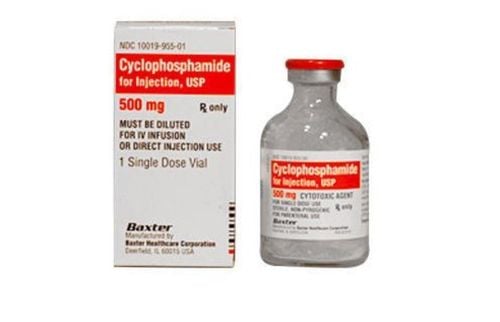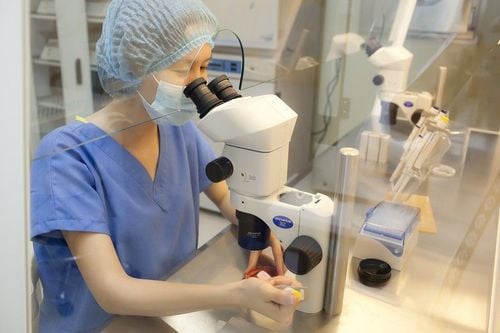This is an automatically translated article.
The article was professionally consulted by Specialist Doctor II Pham Thi Tuyet Mai - Obstetrician and Gynecologist - Department of Obstetrics and Gynecology - Vinmec Hai Phong International General Hospital.Normally, a woman's menstrual cycle falls between 28-30 days and there will be one ovulation, the ovulatory phase is when the follicle has grown to a certain size (16-26mm). ) then ruptures and hurls off to a pre-recorded tubule in the uterus.
Each month, the follicle will ripen once, the day when the follicle matures is about 1/2 of a menstrual cycle, that is, for women with a 28-day menstrual cycle, it falls on the 14th day of the menstrual cycle. from the date of menstruation. For women with a menstrual cycle of 30 days, it will fall on the 15th day from the day of menstruation. However, there are still some cases due to sudden excitement that ovulation occurs on any of those days.
1. What is an ovarian cyst?
The cyst carries genetic material, it is the largest cell in the body made up of three parts: the nucleus, the protoplasm and the outer membrane. Ripe ovules will be spherical, smaller in size than millet, pale yellow in color. Observing the formation of follicles has great significance for infertile couples, because it contributes to increasing the chances of conception for these couples.
2. Follicle development
Follicle development is the process of developing from a primordial follicle, which in turn goes through stages: primary, secondary, cystic, and finally becomes a preovulatory follicle.
In a woman's ovaries, there are always follicles at different stages because this process takes place continuously and overlaps each other. 120 days is the time for 1 follicle maturation process. This is the development of the ovarian follicle.
At each primordial, primary, and secondary follicular stage, with a cavity until it becomes pre-ovulatory, the oocyte has a different structure with different shapes. but they all have the following components:
nucleus (carrying genetic material) protoplasm (fluid compartment, cells around the ovule) Outer membrane (inner shell cells, outer shell, layers of granulosa cells, basement membrane, system) capillary reticulum) Ovarian cysts are formed from germ cells (oocyte cysts) that occur in the ovary. In theory, the average woman can produce about 400,000 eggs in a lifetime, but in practice can only produce 1/1000 of that number (about 400 follicles). The rest are mostly unripe and degenerate.
Follicles are formed through two stages: the recruitment phase of the oocysts and the selection phase.
Recruitment of oocysts: Every month there will be an average of about 20 primordial follicles, they are assembled and developed, the amount of these recruited oocysts varies with the age of the woman and depends on the number of follicles. oocyte remaining in the egg. When the follicles are asleep to ensure the survival of the species, the oocysts are recruited continuously. Follicle selection: This selection takes place around day 7 of the cycle. Follicle selection eliminates weak follicles that are not capable of growth and development, finding an oocyte that is superior to other follicles. The preponderance of the follicle: On the days from 8-10 days from the day of menstruation. Out of about 20 primordial follicles, there will be one superior oocyte, this oocyte is selected to become an adult oocyte with a size of about 5.5-8mm, which is significantly superior to day 7 -10 in size. The size of the follicle falls to about 13mm. Degeneration of a cyst: Out of 20 primordial oocysts, only one superior oocyte is selected. The rest of the primordial oocysts will be destroyed and lost. The growth of oocysts: After elimination, the primordial oocysts are not eligible to grow. At the same time, it also secretes hormones to destroy other follicles. The superior oocyst is protected, enclosed in vegetative cells, given certain nutrients by the vegetative cells to nourish the mature oocyte. Follicle development: Mature follicles are about 16-26mm in size, the oocyst is protected by layers of cells and uses nutrients to grow day by day. Ovulation is when an ovum is released and can be fertilized. The ovum breaks off and is released to the fallopian tube to meet sperm. To reach the ovulatory stage is when experiencing a series of hormonal events, the time of ovulation varies relatively large for each cycle in different women, there are different ovulation times even. It even changes in one woman.
Ovulation is a process by which an ovum can be fertilized on the 14th day from the start of menstruation. The oocyte is released at this 14th time (for men who menstruate about 28 days/1 cycle.
It can be affirmed that, ovulation is not sudden, but it occurs after a series of events, At the end of that chain of events, an ovum and the granulosa cells surrounding it are released. causes other oocysts to not be recruited, reducing their secretory capacity and leading to degeneration.
Please dial HOTLINE for more information or register for an appointment HERE. Download MyVinmec app to make appointments faster and to manage your bookings easily.














